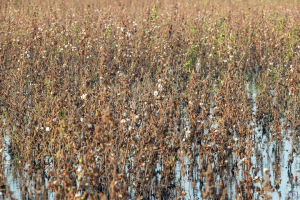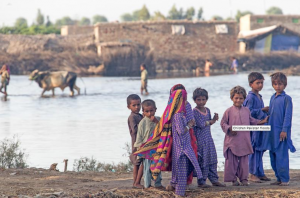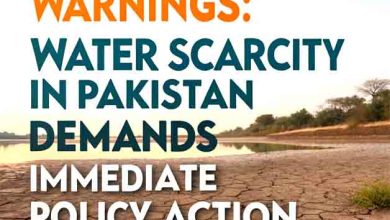In late August in Nowshera District of Khyber Pakhtunkhwa, the rains started falling. When they were told by friends there was a danger of flash floods, Muhammad Ilyas and his family at first thought they would be safe.
“Initially, my family and I did not take the warning seriously, as our area is a good two kilometres from the bank of the Kabul River,” he said.
But door-to-door announcements followed soon after, and after that, ominous warnings from the mosque loudspeakers.
“It seemed unreal, and we didn’t have time to think and plan. We quickly decided to relocate the women and children in our family to a safe area, which was around five kilometres away from our home.”
Carrying only necessities such as clothing and bedding, the family left everything else behind. Still Muhammad decided to stay, hoping against hope.
“But the hope started vanishing as I noticed water gushing in. I had to leave my home.”
Pakistan is in a flood basin, so Pakistanis are used to floods. Once every decade or so, it rains more than expected, the rivers well up and cause damage. A population resigned to their fate takes stock of their losses, sheds a tear and resume their daily struggles as they always have.
But not this year.
The rains were unlike any ever before.
Pakistan received three to five times more than its 30-year average rainfall. This torrential outpour washed away the already frail infrastructure, disconnected many cities from the rest of the country, and, in the case of Balochistan, an entire province. It eradicated complete villages from the face of earth.
At the height of the storm, one third of the country was covered in water.
It has affected about 33 million people, most already living in woeful conditions.
Nearly 1,700 people have died. Some 7.9 million have been displaced and about 6.4 million need humanitarian assistance.
The rainy season is nearly over, but Pakistanis know, from hard experience, that the worst is yet to come.
When Muhammad and his father returned to their home as the waters receded, to assess the damage, they were met with an appalling sight.
“Almost everything was destroyed including beds, wooden furniture, mattresses, food items and home appliances. It took us many years to save money and buy these items, and it took only 24 hours for the water to destroy everything.”
The structure of their house is also extensively damaged. The boundary walls are wrecked, the inner walls are cracked and crumbling and will likely fall down.
Muhammad and his family know full well that the standing water which remains in the village means bad news.
Pakistan’s health sector is in no condition to deal with the disease outbreak that is sure to follow. Mosquitoes are already on the rampage. Clean drinking water, previously available in precious little quantity, has become even more scarce. People are forced to relieve themselves in the open, close to the areas where they have sought shelter, raising the likelihood of disease outbreaks. Seventy-two thousand births are expected amongst the displaced in November, according to an unconfirmed estimate. Very few of these expectant women will receive any medical assistance.
The floods also mean dire news for the agricultural industry.
Large areas of valuable agricultural land are still under water. The wheat planting season is almost here. If the water does not drain in time, farmers will not be able to plant, and next year’s harvest will suffer.
Even in normal years, despite being an agricultural country, Pakistan does not produce enough wheat to feed itself. It is quite likely that even more wheat will need to be imported next year, putting an additional burden on the country’s precarious balance of payments.
The flood has also devastated the cotton crop, which means that the textile export will suffer, and the economy will take another blow.
As always, the people of Pakistan have come forward and helped their neighbours as much as possible. Numerous NGOs have been working to provide shelter, food and emergency relief supplies. Yet, the need of the victims of this disaster is far greater. Pakistan is in dire need of international help.
Families like Muhammad’s need absolutely everything—from jobs, to blankets, to clean drinking water, to treatment for diseases such as dengue, diarrhea and skin rashes. Muhammad’s children are getting treatment at medical camps in their area, and water is being distributed through tankers by the district administration and local relief organizations.
“We are still without power due to the floods. We need urgent restoration of electricity or any alternate source such as solar electricity. Most of the families in our areas are underprivileged. They can’t afford to rebuild or repair their houses and the winter is approaching fast.”
Thirty three million people have been affected by the floods in Pakistan. People need the means to restore their livelihoods so that they can get back on their feet. To build forward better, recovery and reconstruction must be climate resilient and inclusive. UNDP has already started working in this space, liaising with partners and the Government of Pakistan on needs assessment. For early recovery, UNDP is also pivoting its existing programming to support the most vulnerable communities.
Story by: Shahzad Ahmed, Communications Officer, UNDP Pakistan and Jamil Akhtar, an international award-winning writer and photographer. Jamil can be reached at info@jamilakhtar.photography







